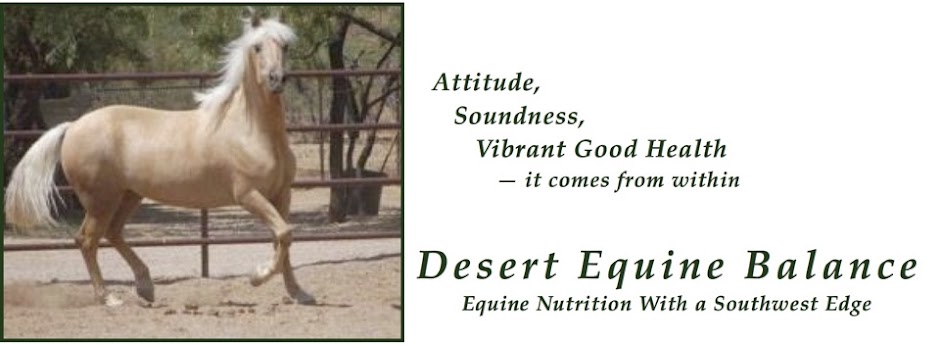The Equine Cushings and Insulin Resistance (ECIR) group, co-owned by equine nutritionist and author Eleanor Kellon, VMD, has long supported using a low sugar/low starch diet for horses showing signs of laminitis, founder, insulin resistance (IR) or Cushing’s disease (PPID - pituitary pars intermedia dysfunction).
The Emergency Temporary Diet by Dr. Eleanor Kellon as posted on the ECIR group is not intended as a long-term complete diet but as an initial measure to bring symptoms under control until hay can be analyzed to check for suitability and mineral balancing. While some horses may begin to show improvement right away when high sugar/high starch triggers are removed from the diet, most won’t show real changes until their diet has been balanced and their trim optimized for a few months.
I have slightly modified the ECIR Group Emergency Diet (with permission from Dr. Kellon) and added some suggestions based on local Southwest availability. The complete article can be read on my website www.desertequinebalance.com and a pdf version is available there to download and print.
 |
| Tested low sugar/starch hay |
- Grass hay - either tested for a total sugar (ESC) plus starch level of <10% or soaked/drained
- Iodized salt - 1to 2 heaping Tablespoons per day to start
- Magnesium - 5 grams until hay is tested (about 2 teaspoons of magnesium oxide)
- Vitamin E - 2,000 IU from natural vitamin E gel caps
- Flax - either fresh ground flax seed or a stabilized flax product
However, the “emergency” diet is a temporary measure and will, at some point, need to be mineral balanced. The ideal way is to have your hay analyzed and use a custom supplement based on the results of the analysis. The analysis will also give you information on digestible energy (DE - calories/energy) which will help guide the amount you need to feed, and crude protein (CP), sugar, starch and mineral levels.
Feeding a custom supplement based on your hay analysis may often cost less than using a quality “off the shelf” supplement. If unable to test your hay there are options for addressing deficiencies and excesses using regional supplements.
Don't spend your hard earned money on expensive specialized supplements until you understand what your horse needs. There are no magic bullets in a bag or bucket that will take the place of an accurate diagnosis, eliminating excessive sugar and starch from your horse's diet, a correct balanced trim and exercise (summarized by Dr. Kellon as DDTE). Once DDTE has been addressed you can take your time finding the most appropriate and cost effective supplements for your horse.
Best regards,
Patti
Desert Hoofprints in lovely cool Vail AZ (which won't, unfortunately, last long)
Links
The “Emergency” Temporary Diet - with modifications and suggestions for Arizona and the Southwest
ECIR Group http://pets.groups.yahoo.com/group/EquineCushings/
NRC Plus equine nutrition courses by Eleanor Kellon, VMDECIR Group http://pets.groups.yahoo.com/group/EquineCushings/
Analyzing Hay and Feeds - http://www.desertequinebalance.com/articles/analyzing-hay-and-feeds



